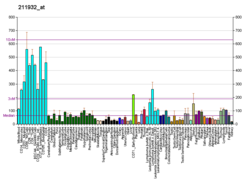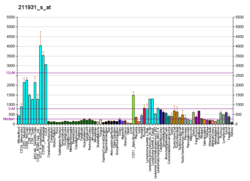| HNRNPA3 |
|---|
|
| Identifiers |
|---|
| Aliases | HNRNPA3, 2610510D13Rik, D10S102, FBRNP, HNRPA3, heterogeneous nuclear ribonucleoprotein A3 |
|---|
| External IDs | OMIM: 605372; MGI: 1917171; GeneCards: HNRNPA3; OMA:HNRNPA3 - orthologs |
|---|
| Gene location (Human) |
|---|
 | | Chr. | Chromosome 2 (human)[1] |
|---|
| | Band | 2q31.2 | Start | 177,212,563 bp[1] |
|---|
| End | 177,223,958 bp[1] |
|---|
|
| Gene location (Mouse) |
|---|
 | | Chr. | Chromosome 2 (mouse)[2] |
|---|
| | Band | 2|2 C3 | Start | 75,489,605 bp[2] |
|---|
| End | 75,499,751 bp[2] |
|---|
|
| RNA expression pattern |
|---|
| Bgee | | Human | Mouse (ortholog) |
|---|
| Top expressed in | - ganglionic eminence
- ventricular zone
- right testis
- left testis
- monocyte
- Brodmann area 23
- left ovary
- left lobe of thyroid gland
- right lobe of thyroid gland
- epithelium of colon
|
| | Top expressed in | - tail of embryo
- neural layer of retina
- ventricular zone
- habenula
- dentate gyrus of hippocampal formation granule cell
- lobe of cerebellum
- cerebellar vermis
- superior cervical ganglion
- ureter
- substantia nigra
|
| | More reference expression data |
|
|---|
| BioGPS | 

 | | More reference expression data |
|
|---|
|
| Gene ontology |
|---|
| Molecular function | - RNA transmembrane transporter activity
- protein binding
- mRNA binding
- nucleic acid binding
- RNA binding
| | Cellular component | - cytoplasm
- messenger ribonucleoprotein complex
- neuron projection
- ribonucleoprotein granule
- catalytic step 2 spliceosome
- spliceosomal complex
- nucleus
- nucleoplasm
- postsynaptic density
- ribonucleoprotein complex
| | Biological process | - mRNA splicing, via spliceosome
- mRNA processing
- mRNA transport
- RNA splicing
- RNA metabolic process
| | Sources:Amigo / QuickGO |
|
| Orthologs |
|---|
| Species | Human | Mouse |
|---|
| Entrez | | |
|---|
| Ensembl | | |
|---|
| UniProt | | |
|---|
| RefSeq (mRNA) | NM_001330247
NM_001330248
NM_001330249
NM_001330250
NM_001330251
|
|---|
NM_194247
NM_001395170 |
| |
|---|
NM_053263
NM_146130
NM_198090
NM_001359971 |
|
|---|
| RefSeq (protein) | NP_001317176
NP_001317177
NP_001317178
NP_001317179
NP_001317180
|
|---|
NP_919223 |
| |
|---|
NP_444493
NP_666242
NP_932758
NP_001346900 |
|
|---|
| Location (UCSC) | Chr 2: 177.21 – 177.22 Mb | Chr 2: 75.49 – 75.5 Mb |
|---|
| PubMed search | [3] | [4] |
|---|
|
| Wikidata |
| View/Edit Human | View/Edit Mouse |
|



















